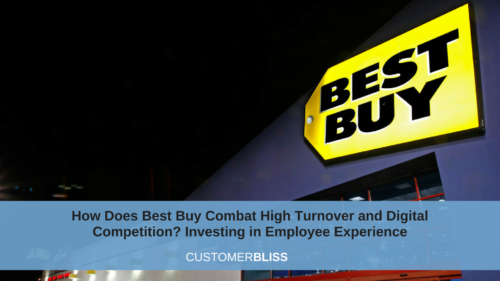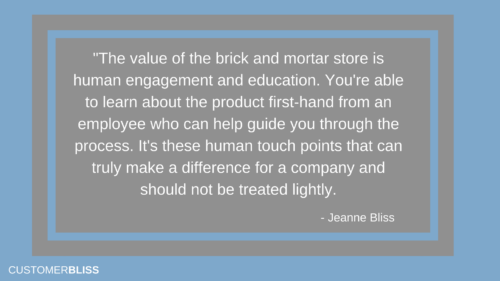
Is your organization taking the time to improve its employees lives? When you improve the lives of your employees, you’re also taking the right steps to improve the lives of your customers.
In an article recently featured in Retail Drive, “Why Best Buy is Investing in Employees,” Corinne Ruff shares how Best Buy’s determination to invest in its employees is driving growth and success for the company.
I love the intro summary to her article, “executives at the big-box retailer have spent the last several years rethinking how to boost customer engagement. Turns out, the employee came first.” Yes, Best Buy gets it!
Fight High Turnover by Investing in Employees
Ruff shares that at a Future Stores Miami conference, executives at big-box retailers discussed how they’ve rethought employee training and invested in support for customer and product interaction. High turnover is a major problem in retail (the average turnover rate is about 60% according to National Retail Federation), and hiring/training ends up being costly.
How do you combat high turnover? Well, look at your internal operations. Best Buy wanted to understand how to improve the employee experience, and started looking within. This is a fundamental step; it’s absolutely critical when starting your CX transformation. Best Buy conducted “hundreds and hundreds” of one-on-one employee interviews across the country to understand the employee UX when it came to applications and other technology uses (including devices used on the sales floor and the POS system). Using technology to streamline transactions with customers is a big portion of employee training and sales floor operations.
By understanding the retail user experience, and rethinking how to train employees to make them more efficient in their jobs, Best Buy has been able to invest in support for both customer and product interaction. This new way of thinking helped Best Buy refine technologies used on the sales floor, improve the overall employee experience, and help decrease turnover.
Treat Your Employees as Assets
 Best Buy is looking at their employees as an investment, which goes back to my first core competency: treat your customers as assets. Amazon is threatening a lot of businesses, and Best Buy wants to differentiate itself with knowledgeable and friendly customer service. This is a great approach because as easy as it is to click your way through a purchase online, when it comes to buying products with a high financial investment like TVs, laptops, and sound systems, you may actually want to visit a physical store.
Best Buy is looking at their employees as an investment, which goes back to my first core competency: treat your customers as assets. Amazon is threatening a lot of businesses, and Best Buy wants to differentiate itself with knowledgeable and friendly customer service. This is a great approach because as easy as it is to click your way through a purchase online, when it comes to buying products with a high financial investment like TVs, laptops, and sound systems, you may actually want to visit a physical store.
The value of the brick and mortar store is human engagement and education. You’re able to learn about the product first-hand from an employee who can help guide you through the process. It’s these human touch points that can truly make a difference for a company and should not be treated lightly.
I also like Best Buy’s realistic approach to CX transformation. Ruff shared an insight from Best Buy’s Vice President of Retail Operations, Shari Rossow, who stated that an overhaul to employee investments and training can’t be done overnight; it’s a complex process that will take time and financial funding. And I couldn’t agree more! Like I previously said, you can’t “boil the ocean” when it comes to this work. Everything has to do be done in manageable pieces in order to truly make a long-term difference for the organization.
Kudos to Shari Rossow and the Best Buy executive team for taking this step! Employees are your company’s cheerleaders and they’re the first line of defense. You need to arm them with the tools and knowledge to do their job effectively in order to create a positive cycle of customer-driven growth.
Employees are your company’s cheerleaders and they’re the first line of defense. You need to arm them with the tools and knowledge to do their job effectively in order to create a positive cycle of customer-driven growth. #CX Click To Tweet




Excellent example, and Best Buy is to be applauded for the focus on employee experience. The only thing I’d add is that this needs to include ALL employees, not just those customer-facing at the store. Employees are more than cheerleaders. In a stakeholder-centric organization, they are ambassadors. As I’ve written in one of my posts on this important subject: “There have been a number of professional and academic studies, in multiple industries, linking employee attitudes and behaviors with the value customers perceive in their experiences.. Through targeted research, and resultant training, communication, process, and reward and recognition programs, what we define as ambassadorship formalizes the direction in which employee engagement has been trending toward for years. Simply, the trend is optimizing and connecting employee commitment to the organization and its goals, to the company’s unique value proposition, and to the customer. This creates a state where all employees are focused on, and tasked with, delivering customer value as part of their job description, irrespective of location, function or level. In other words, though there needs to be coordination and management of initiatives through HR and a CXO/CCO, everyone in the company, from the file clerk to the CEO, has this day-to-day responsibility embedded within their job descriptions..”